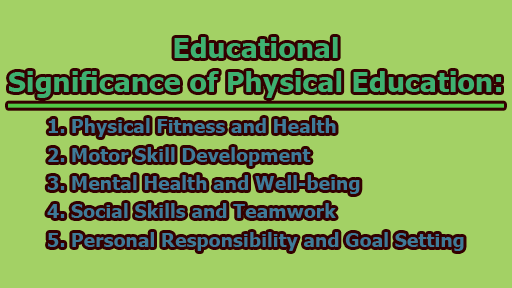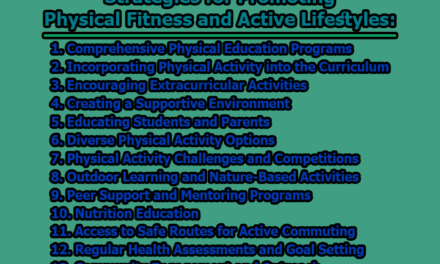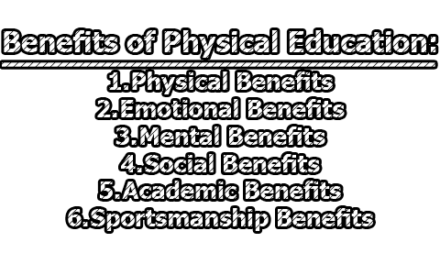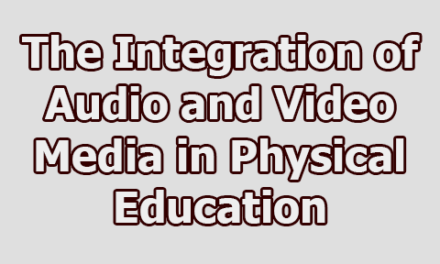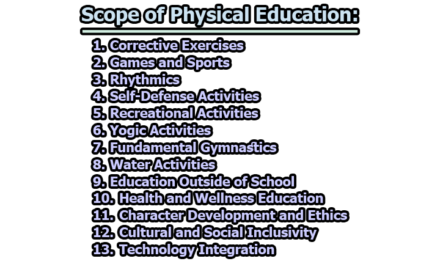Educational Significance of Physical Education:
Physical Education (PE) is a fundamental component of the educational system that transcends the boundaries of the traditional classroom. Beyond its role in promoting physical fitness, PE plays a pivotal role in shaping well-rounded individuals. Here, we delve into the educational significance of Physical Education.
1. Physical Fitness and Health: Physical Education plays a central role in enhancing physical fitness and overall health. It provides students with structured opportunities to engage in physical activities that target cardiovascular endurance, muscular strength, flexibility, and coordination (American Heart Association, 2019). These components of physical fitness contribute not only to a healthier lifestyle but also to the prevention of chronic diseases such as heart disease, obesity, and diabetes.
Physical Education programs often include a variety of activities, from aerobic exercises to strength training and flexibility exercises. These activities help students build a solid foundation for lifelong physical well-being and empower them to make informed choices about their health (Centers for Disease Control and Prevention, 2017).
2. Motor Skill Development: Motor skill development is a critical educational goal of Physical Education, particularly for young learners. Fundamental motor skills encompass a broad range of movements, including running, jumping, hopping, catching, throwing, and kicking (NASPE, 2015). Proficiency in these skills not only enables students to participate effectively in sports and physical activities but also plays a pivotal role in their cognitive and social development.
Motor skill development in Physical Education occurs in a structured and progressive manner. Students move from mastering basic skills to more complex ones, promoting not only physical competence but also self-confidence and problem-solving abilities (Gallahue & Ozmun, 2006).
3. Mental Health and Well-being: Physical Education significantly impacts mental health and emotional well-being. Engaging in regular physical activities has been linked to numerous mental health benefits. These include reduced stress, anxiety, and depression, as well as improved mood and cognitive function (WHO, 2021). Physical activity stimulates the release of endorphins, which are natural mood lifters, and reduces the production of stress hormones, leading to a sense of well-being.
Physical Education classes provide a structured environment for students to manage stress, build emotional resilience, and cultivate a positive mindset. These classes offer opportunities for mindfulness and relaxation techniques, helping students develop coping strategies that can be applied throughout their lives (McDonald & Hodgdon, 2019).
4. Social Skills and Teamwork: Physical Education places a strong emphasis on social skills and teamwork, particularly through activities such as team sports. Participation in team sports requires students to collaborate, communicate, and form relationships with their peers (NAPES, 2020). They learn essential life skills such as cooperation, leadership, and conflict resolution, which are transferable to various aspects of life.
Team-based activities in Physical Education also promote inclusivity and respect for individual differences. Students learn to appreciate diversity and work harmoniously with classmates from various backgrounds and abilities, fostering a sense of belonging and community (Burdette & Whitaker, 2005).
5. Personal Responsibility and Goal Setting: Personal responsibility and goal setting are integral components of Physical Education. Students are encouraged to take ownership of their health and well-being by setting fitness goals, monitoring their progress, and making necessary adjustments (International Journal of Physical Education, Sports, and Health, 2019). This process instills vital life skills, including discipline, time management, and the ability to work towards long-term objectives.
Goal setting in Physical Education is a dynamic process that involves identifying specific, measurable, achievable, relevant, and time-bound (SMART) objectives. By achieving these goals, students not only enhance their physical fitness but also develop the self-efficacy and determination needed to excel in other areas of their lives (Locke & Latham, 2002).
From the above discussion, we can say that Physical Education extends far beyond the realm of physical activity; it is a holistic educational endeavor that molds well-rounded individuals. By prioritizing physical fitness, motor skill development, mental health, social skills, and personal responsibility, PE significantly contributes to a student’s comprehensive development. In today’s increasingly sedentary world, recognizing the educational significance of Physical Education is critical. It equips students not only with the tools for a healthier life but also with the skills and mindset necessary for success in various facets of life. Thus, it remains an essential and indispensable component of the educational journey.
References:
- American Heart Association. (2019). Physical Activity and Children. https://www.heart.org/en/healthy-living/fitness/fitness-basics/aha-recs-for-physical-activity-in-children
- Centers for Disease Control and Prevention. (2017). Physical Activity Basics. https://www.cdc.gov/physicalactivity/basics/index.htm
- National Association for Sport and Physical Education (NASPE). (2015). Physical Education Is Critical to Educating the Whole Child.
- Gallahue, D. L., & Ozmun, J. C. (2006). Understanding motor development: Infants, children, adolescents, adults (6th ed.). McGraw-Hill.
- World Health Organization (WHO). (2021). Physical activity and young people.
- McDonald, J., & Hodgdon, K. (2019). Physical activity and mental health in children and adolescents: A review of reviews. Contemporary School Psychology, 23(2), 129-139.
- Burdette, H. L., & Whitaker, R. C. (2005). Resurrecting free play in young children: Looking beyond fitness and fatness to attention, affiliation, and affect. Archives of Pediatrics & Adolescent Medicine, 159(1), 46-50.
- International Journal of Physical Education, Sports, and Health. (2019). Role of Physical Education in Developing Personal Responsibility and Goal Setting in Students.
- Locke, E. A., & Latham, G. P. (2002). Building a practically useful theory of goal setting and task motivation: A 35-year odyssey. American Psychologist, 57(9), 705-717.

Assistant Teacher at Zinzira Pir Mohammad Pilot School and College

